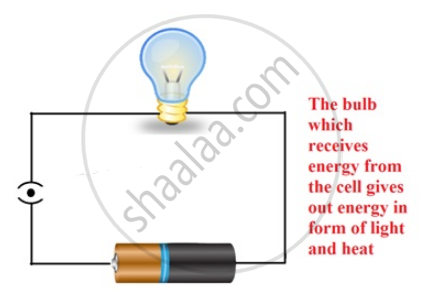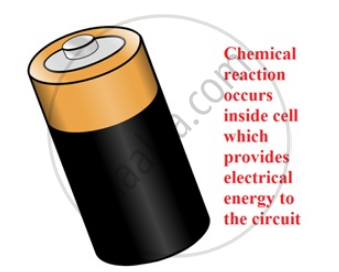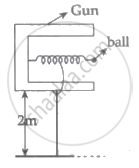Topics
Physical World and Measurement
Physical World
Units and Measurements
- International System of Units
- Measurement of Length
- Measurement of Mass
- Measurement of Time
- Accuracy, Precision and Least Count of Measuring Instruments
- Errors in Measurements
- Significant Figures
- Dimensions of Physical Quantities
- Dimensional Formulae and Dimensional Equations
- Dimensional Analysis and Its Applications
- Need for Measurement
- Units of Measurement
- Fundamental and Derived Units
- Length, Mass and Time Measurements
- Introduction of Units and Measurements
Motion in a Straight Line
- Position, Path Length and Displacement
- Average Velocity and Average Speed
- Instantaneous Velocity and Speed
- Kinematic Equations for Uniformly Accelerated Motion
- Acceleration (Average and Instantaneous)
- Relative Velocity
- Elementary Concept of Differentiation and Integration for Describing Motion
- Uniform and Non-uniform Motion
- Uniformly Accelerated Motion
- Position-time, Velocity-time and Acceleration-time Graphs
- Position - Time Graph
- Relations for Uniformly Accelerated Motion (Graphical Treatment)
- Introduction of Motion in One Dimension
- Motion in a Straight Line
Kinematics
Motion in a Plane
- Scalars and Vectors
- Multiplication of Vectors by a Real Number or Scalar
- Addition and Subtraction of Vectors - Graphical Method
- Resolution of Vectors
- Vector Addition – Analytical Method
- Motion in a Plane
- Motion in a Plane with Constant Acceleration
- Projectile Motion
- Uniform Circular Motion (UCM)
- General Vectors and Their Notations
- Motion in a Plane - Average Velocity and Instantaneous Velocity
- Rectangular Components
- Scalar (Dot) and Vector (Cross) Product of Vectors
- Relative Velocity in Two Dimensions
- Cases of Uniform Velocity
- Cases of Uniform Acceleration Projectile Motion
- Motion in a Plane - Average Acceleration and Instantaneous Acceleration
- Angular Velocity
- Introduction of Motion in One Dimension
Laws of Motion
Work, Energy and Power
Laws of Motion
- Aristotle’s Fallacy
- The Law of Inertia
- Newton's First Law of Motion
- Newton’s Second Law of Motion
- Newton's Third Law of Motion
- Conservation of Momentum
- Equilibrium of a Particle
- Common Forces in Mechanics
- Circular Motion and Its Characteristics
- Solving Problems in Mechanics
- Static and Kinetic Friction
- Laws of Friction
- Inertia
- Intuitive Concept of Force
- Dynamics of Uniform Circular Motion - Centripetal Force
- Examples of Circular Motion (Vehicle on a Level Circular Road, Vehicle on a Banked Road)
- Lubrication - (Laws of Motion)
- Law of Conservation of Linear Momentum and Its Applications
- Rolling Friction
- Introduction of Motion in One Dimension
Work, Energy and Power
- Introduction of Work, Energy and Power
- Notions of Work and Kinetic Energy: the Work-energy Theorem
- Kinetic Energy (K)
- Work Done by a Constant Force and a Variable Force
- Concept of Work
- Potential Energy (U)
- Conservation of Mechanical Energy
- Potential Energy of a Spring
- Various Forms of Energy : the Law of Conservation of Energy
- Power
- Collisions
- Non - Conservative Forces - Motion in a Vertical Circle
Motion of System of Particles and Rigid Body
System of Particles and Rotational Motion
- Motion - Rigid Body
- Centre of Mass
- Motion of Centre of Mass
- Linear Momentum of a System of Particles
- Vector Product of Two Vectors
- Angular Velocity and Its Relation with Linear Velocity
- Torque and Angular Momentum
- Equilibrium of Rigid Body
- Moment of Inertia
- Theorems of Perpendicular and Parallel Axes
- Kinematics of Rotational Motion About a Fixed Axis
- Dynamics of Rotational Motion About a Fixed Axis
- Angular Momentum in Case of Rotation About a Fixed Axis
- Rolling Motion
- Momentum Conservation and Centre of Mass Motion
- Centre of Mass of a Rigid Body
- Centre of Mass of a Uniform Rod
- Rigid Body Rotation
- Equations of Rotational Motion
- Comparison of Linear and Rotational Motions
- Values of Moments of Inertia for Simple Geometrical Objects (No Derivation)
Gravitation
Gravitation
- Kepler’s Laws
- Newton’s Universal Law of Gravitation
- The Gravitational Constant
- Acceleration Due to Gravity of the Earth
- Acceleration Due to Gravity Below and Above the Earth's Surface
- Acceleration Due to Gravity and Its Variation with Altitude and Depth
- Gravitational Potential Energy
- Escape Speed
- Earth Satellites
- Energy of an Orbiting Satellite
- Geostationary and Polar Satellites
- Weightlessness
- Escape Velocity
- Orbital Velocity of a Satellite
Properties of Bulk Matter
Mechanical Properties of Solids
- Elastic Behaviour of Solid
- Stress and Strain
- Hooke’s Law
- Stress-strain Curve
- Young’s Modulus
- Determination of Young’s Modulus of the Material of a Wire
- Shear Modulus or Modulus of Rigidity
- Bulk Modulus
- Application of Elastic Behaviour of Materials
- Elastic Energy
- Poisson’s Ratio
Thermodynamics
Behaviour of Perfect Gases and Kinetic Theory of Gases
Mechanical Properties of Fluids
- Thrust and Pressure
- Pascal’s Law
- Variation of Pressure with Depth
- Atmospheric Pressure and Gauge Pressure
- Hydraulic Machines
- Streamline and Turbulent Flow
- Applications of Bernoulli’s Equation
- Viscous Force or Viscosity
- Reynold's Number
- Surface Tension
- Effect of Gravity on Fluid Pressure
- Terminal Velocity
- Critical Velocity
- Excess of Pressure Across a Curved Surface
- Introduction of Mechanical Properties of Fluids
- Archimedes' Principle
- Stoke's Law
- Equation of Continuity
- Torricelli's Law
Oscillations and Waves
Thermal Properties of Matter
- Heat and Temperature
- Measurement of Temperature
- Ideal-gas Equation and Absolute Temperature
- Thermal Expansion
- Specific Heat Capacity
- Calorimetry
- Change of State - Latent Heat Capacity
- Conduction
- Convection
- Radiation
- Newton’s Law of Cooling
- Qualitative Ideas of Black Body Radiation
- Wien's Displacement Law
- Stefan's Law
- Anomalous Expansion of Water
- Liquids and Gases
- Thermal Expansion of Solids
- Green House Effect
Thermodynamics
- Thermal Equilibrium
- Zeroth Law of Thermodynamics
- Heat, Internal Energy and Work
- First Law of Thermodynamics
- Specific Heat Capacity
- Thermodynamic State Variables and Equation of State
- Thermodynamic Process
- Heat Engine
- Refrigerators and Heat Pumps
- Second Law of Thermodynamics
- Reversible and Irreversible Processes
- Carnot Engine
Kinetic Theory
- Molecular Nature of Matter
- Gases and Its Characteristics
- Equation of State of a Perfect Gas
- Work Done in Compressing a Gas
- Introduction of Kinetic Theory of an Ideal Gas
- Interpretation of Temperature in Kinetic Theory
- Law of Equipartition of Energy
- Specific Heat Capacities - Gases
- Mean Free Path
- Kinetic Theory of Gases - Concept of Pressure
- Assumptions of Kinetic Theory of Gases
- RMS Speed of Gas Molecules
- Degrees of Freedom
- Avogadro's Number
Oscillations
- Periodic and Oscillatory Motion
- Simple Harmonic Motion (S.H.M.)
- Simple Harmonic Motion and Uniform Circular Motion
- Velocity and Acceleration in Simple Harmonic Motion
- Force Law for Simple Harmonic Motion
- Energy in Simple Harmonic Motion
- Some Systems Executing Simple Harmonic Motion
- Damped Simple Harmonic Motion
- Forced Oscillations and Resonance
- Displacement as a Function of Time
- Periodic Functions
- Oscillations - Frequency
- Simple Pendulum
Waves
- Reflection of Transverse and Longitudinal Waves
- Displacement Relation for a Progressive Wave
- The Speed of a Travelling Wave
- Principle of Superposition of Waves
- Introduction of Reflection of Waves
- Standing Waves and Normal Modes
- Beats
- Doppler Effect
- Wave Motion
- Speed of Wave Motion
- Heat
- Chemical Energy
- Electrical Energy
- The Equivalence of Mass and Energy
- Nuclear Energy
- The Principle of Conservation of Energy
Notes
Various forms of energy
Heat:
-
A block of mass m sliding on a rough horizontal surface with speed v0 comes to a halt over a distance x0.
The work done by the force of kinetic friction f over x0 is –fx0.
By the work-energy theorem, `(mv_o^2)/2 = fx_0.` -
If we confine our scope to mechanics, we would say that the kinetic energy of the block is ‘lost’ due to the frictional force.
On examination of the block and the table we would detect a slight increase in their temperatures. -
The work done by friction is not ‘lost’, but is transferred as heat energy.
This raises the internal energy of the block and the table.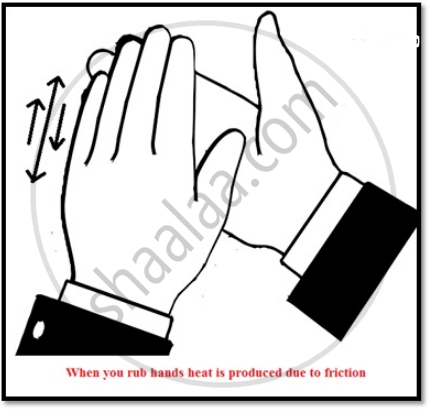
-
In winter, in order to feel warm, we generate heat by vigorously rubbing our palms together.
-
A quantitative idea of the transfer of heat energy is obtained by noting that 1 kg of water releases about 42000 J of energy when it cools by 10°C.
Chemical Energy:
-
Chemical energy arises from the fact that the molecules participating in the chemical reaction have different binding energies.
-
If the total energy of the reactants is more than the products of the reaction, heat is released and the reaction is said to be an exothermic reaction.
Example- When you freeze water you remove energy from water to lower its temperature and its phase is changed to ice, so it is a exothermic process. -
If the reverse is true, heat is absorbed and the reaction is endothermic.
Example- While melting the ice you provide energy to the ice to increase its temperature and change its phase to water, so it is a endothermic process.
-
Coal consists of carbon and a kilogram of it when burnt releases about 3 × 107 J of energy.
-
Chemical energy is associated with the forces that give rise to the stability of substances. These forces bind atoms into molecules, molecules into polymeric chains, etc.
-
The chemical energy arising from the combustion of coal, cooking gas, wood and petroleum is indispensable to our daily existence.
The Equivalence of Mass and Energy
-
Physicists believed that in every physical and chemical process, the mass of an isolated system is conserved till Albert Einstein show the relation, E = mc2 where c, the speed of light in vacuum is approximately 3 ×108 m s–1
-
This equation showed that mass and energy are equivalent and are related by E = m c2.
-
If there is a difference between the sum of reactants and products that difference, dm, is called mass defect.
-
In case of chemical reactions the mass defect is very small and can be neglected, but in the case of nuclear reactions this becomes significant.
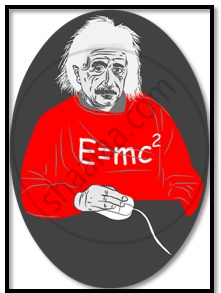
Nuclear Energy:
-
The energy released from the nuclear reactions, either fission or fusion, is called as nuclear energy.
-
Nuclear fusion and fission are manifestations of the equivalence of mass and energy.
-
In fusion light atom nuclei like Hydrogen fuse to form a bigger nucleus whose mass is less than the sum of the masses of the reactants.
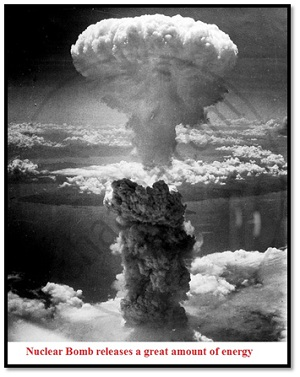
-
In fission, a heavy nucleus like uranium 235U92, is split by a neutron into lighter nuclei. Once again the final mass is less than the initial mass and the mass difference translates into energy.
Strictly, the energy ∆E released in a chemical reaction can also be related to the mass defect `∆m = (∆E)/(c^2)`. However, for a chemical reaction, this mass defect is much smaller than for a nuclear reaction. Table below lists the total energies for a variety of events and phenomena.
Approximate energy associated with various phenomena
| Description | Energy (J) |
| Big Bang | 1068 |
| Radio energy emitted by the galaxy during its lifetime | 1055 |
| Rotational energy of the Milky Way | 1052 |
| Energy released in a supernova explosion | 1044 |
| Oceans's hydrogen in fusion | 1034 |
| Rotational energy of the earth | 1029 |
| Annual solar energy incident on the earth | 5 × 1021 |
| Annual wind energy dissipated near earth's surface | 1022 |
| Annual global energy usage by human | 3 × 1020 |
| Annual energy dissipated by the tides | 1020 |
| Energy release of 15-megaton fusion bomb | 1017 |
| Annual electrical output of large generating plant | 1016 |
| Thunderstorm | 1015 |
| Energy released in burning 1000 kg of coal | 3 × 1010 |
| Kinetic energy of a large jet aircraft | 109 |
| Energy released in burning 1 litre of gasoline | 3 × 107 |
| Daily food intake of a human adult | 107 |
| Work done by a human heart per beat | 0.5 |
| Turning this page | 10-3 |
| Flea hop | 10-7 |
| Discharge of a single neuron | 10-10 |
| Typical energy of a proton in a nucleus | 10-13 |
| Typical energy of an electron in an atom | 10-18 |
| Energy to break one bond in DNA | 10-20 |
Electrical Energy:
-
The flow of electrical current causes bulbs to glow, fans to rotate and bells to ring.
-
Energy is associated with an electric current.
-
There are laws governing the attraction and repulsion of charges and currents, which we shall learn later.
-
An urban Indian household consumes about 200 J of energy per second on an average.
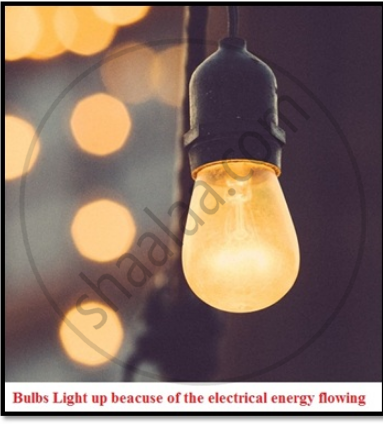
Principle of Conservation of Energy
-
If the forces involved are non-conservative, part of the mechanical energy may get transformed into other forms such as heat, light and sound.
-
However, the total energy of an isolated system does not change.
-
Since the universe as a whole may be viewed as an isolated system, the total energy of the universe is constant.
-
The sum of all kinds of energies in an isolated system remains constant at all times.
